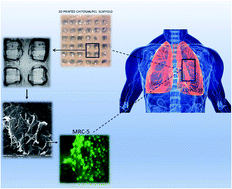3D printed chitosan/polycaprolactone scaffold for lung tissue engineering: hope to be useful for COVID-19 studies
Abstract
To prevent or reduce mortality from lung diseases, new biological materials and scaffolds are needed to conduct more accurate research and support lung tissue regeneration. On the other hand, the outbreak of the COVID-19 virus and its targeting of the human lung has caused many deaths worldwide. The main aim of this study was to provide a biologically and mechanically suitable 3D printed scaffold using chitosan/polycaprolactone bioink for lung tissue engineering. Design-Expert software was employed for studying various compositions for 3D printing. The selected scaffolds underwent physiochemical, biological and mechanical studies to evaluate if they are capable of MRC-5 cell line growth, proliferation, and migration. Based on the results, the average diameter of the chitosan/polycaprolactone strands was measured at 360 μm. Chitosan concentration controlled the printability, while changes in polycaprolactone content did not affect printability. The scaffolds showed excellent potential in swelling, degradation, and mechanical behavior, although they can be modified by adjusting the polycaprolactone content. The scaffolds also revealed notable cell adhesion, nontoxicity, low apoptosis, high proliferation, and cell biocompatibility in vitro. To sum up, scaffold 3 (chitosan/polycaprolactone ratio: 4 : 1) revealed better activity for MRC-5 cell culture. Thereby, this scaffold can be a good candidate for lung tissue engineering and may be applicable for more studies on the COVID-19 virus.



 Please wait while we load your content...
Please wait while we load your content...